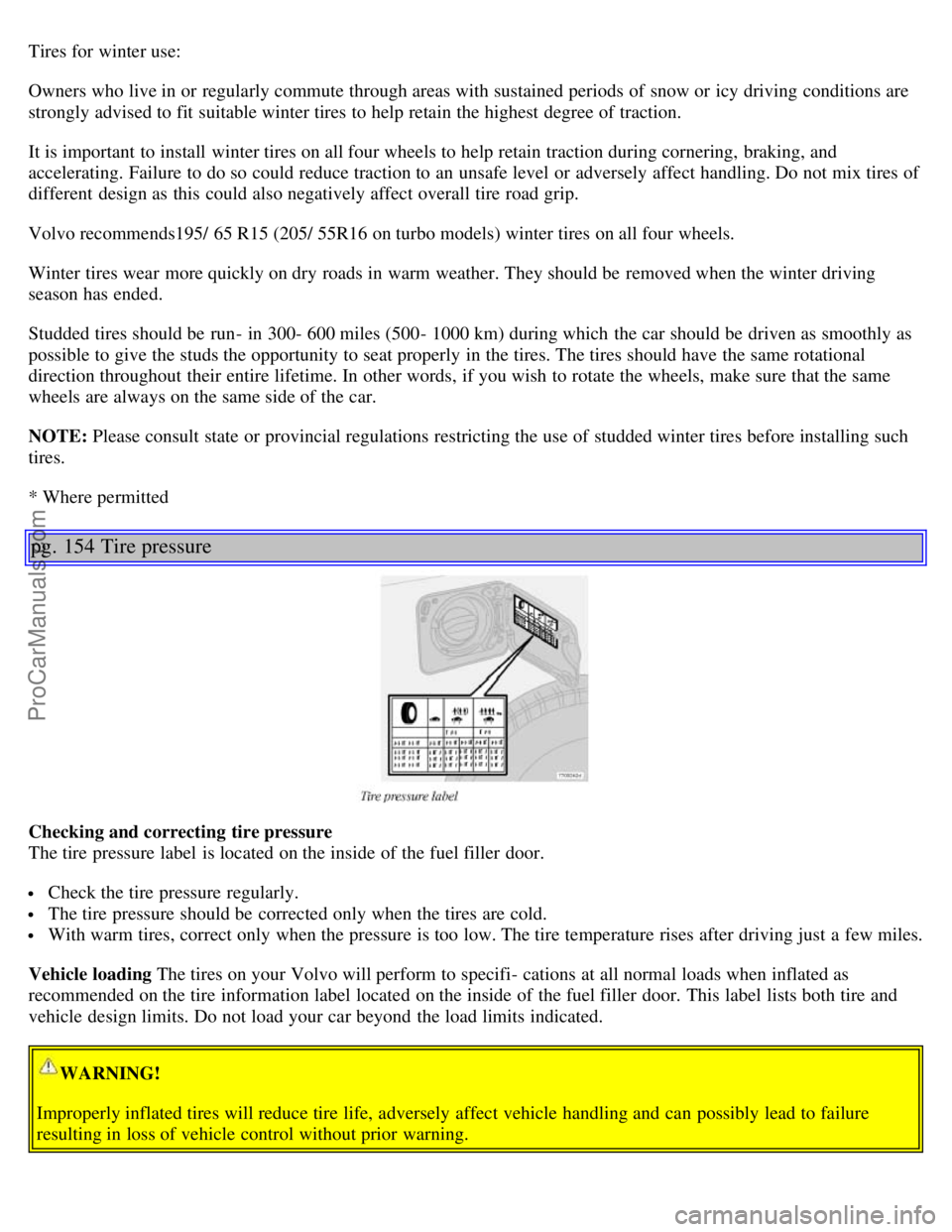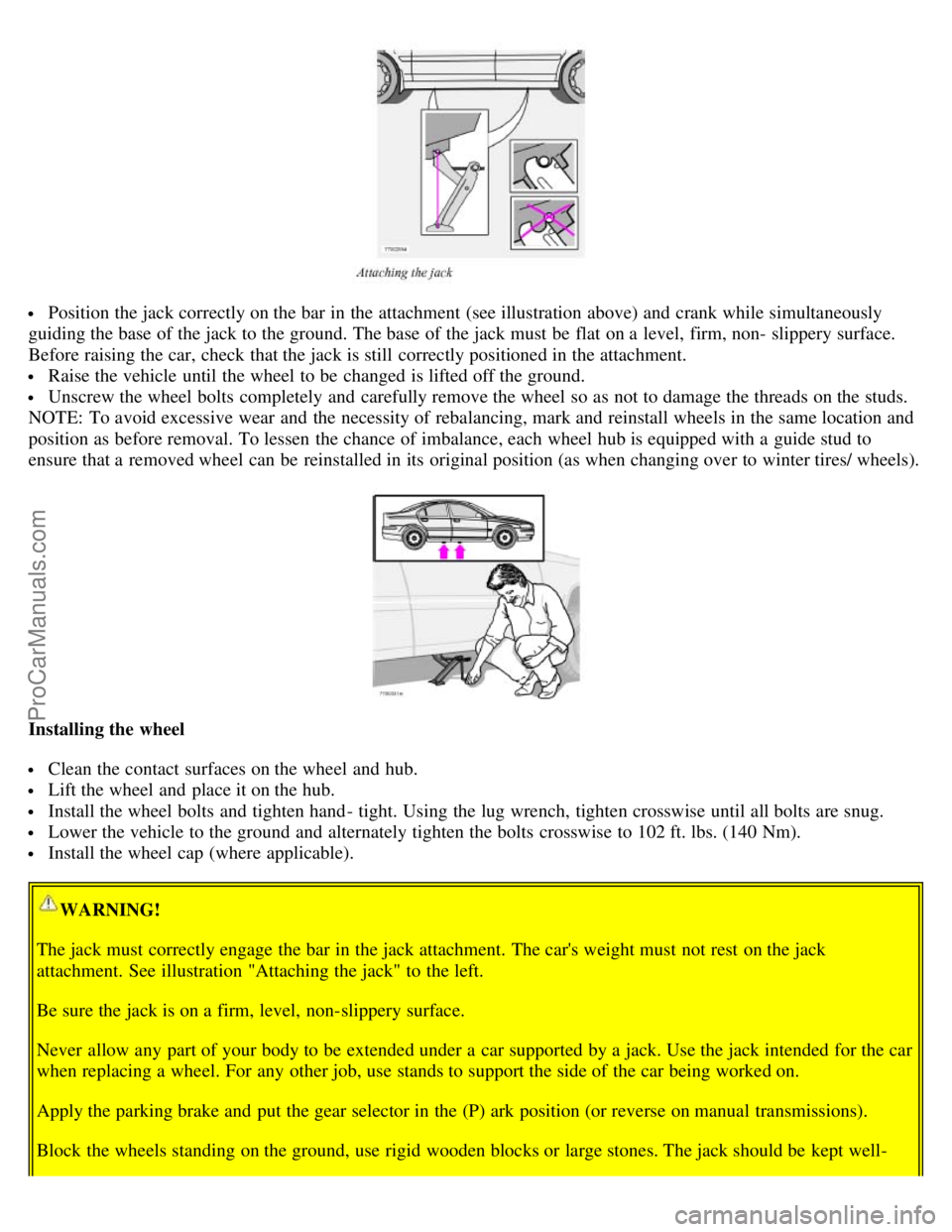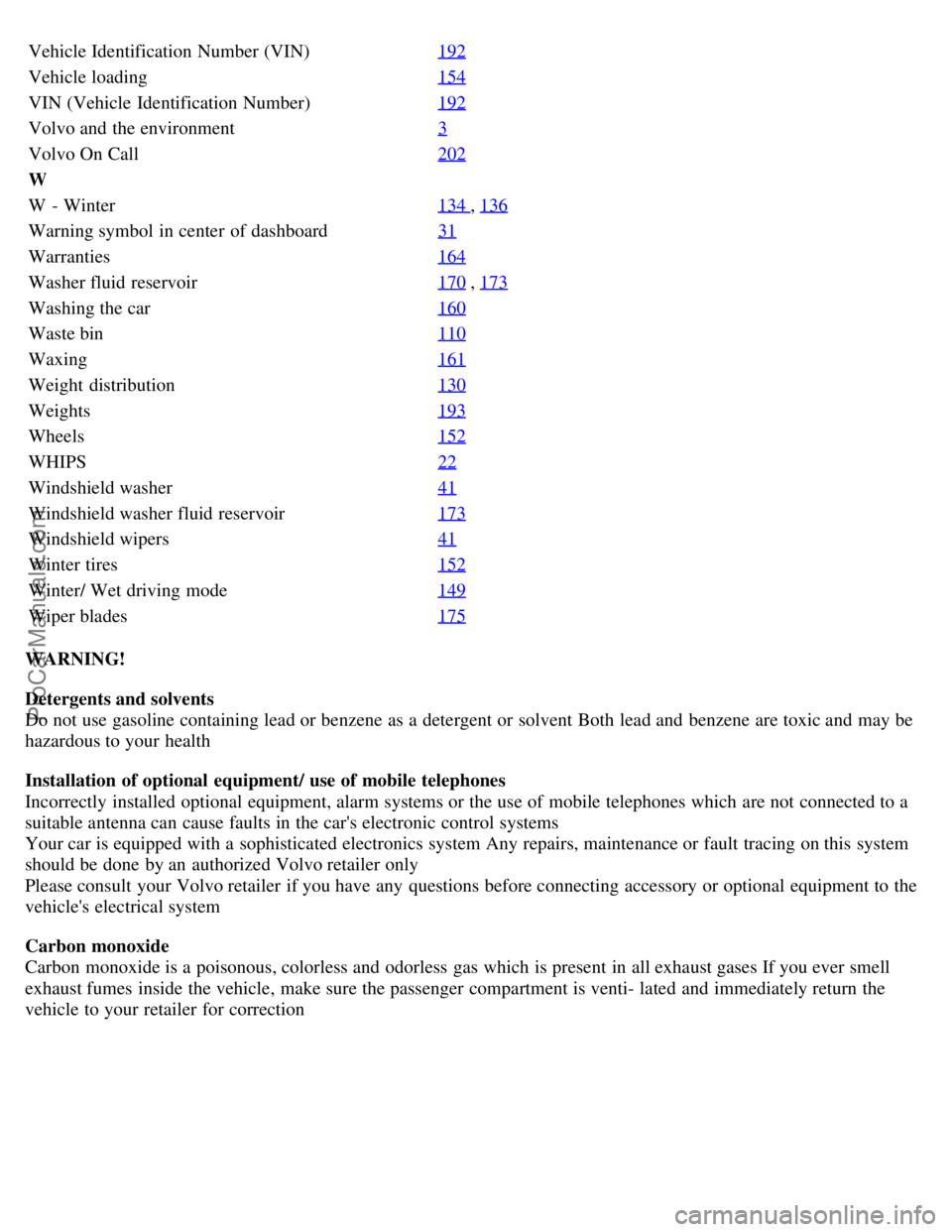2001 VOLVO S60 winter tires
[x] Cancel search: winter tiresPage 90 of 128

2 0 0 1
VOLVO S60
Wheels and tires
pg. 151 Wheels and tires
General information 152
Tire pressure154
Tread wear indicators155
Changing wheels156
Uniform Tire Quality Grading158
pg. 152 General information
General information about wheels and tires
Your vehicle is equipped with tires according to the tire information label on the inside of the fuel filler door.
All tires have a dimension designation.
Example of designation: 215/ 55R16.
215 section width (mm)
55 relationship between section
height and width
R radial tire
16 wheel rim diameter (")
The tires have good road holding characteristics and offer good handling on dry and wet surfaces. It should be noted
however that the tires have been developed to give these features on snow/ ice- free surfaces.
Certain models are equipped with "all- season" tires, which provide a somewhat higher degree of road holding
on slippery surfaces than tires without the "all- season" rating. However, for optimum road holding on icy or
snow-covered roads - we recommend suitable winter tires on all four wheels. When replacing tires, be sure that the
new tires are the same size designation, type (radial) and preferably from the same manufacturer, on all four wheels.
Otherwise there is a risk of altering the car's roadholding and handling characteristics.
NOTE: When storing wheel/ tire assemblies (e. g. winter tires and wheels), either stand the assemblies upright, or
suspend them off the ground. Laying wheel/ tire assemblies on their sides for prolonged periods can cause wheel and/
or tire damage.
New tires
Remember that tires are perishable goods. This tire was manufactured week 15 in 1998! (158). As of 2000,
manufacturing year and week will be indicated with 4 digits (e. g. 0015 means that the tire is manufactured year 2000,
ProCarManuals.com
Page 92 of 128

Tires for winter use:
Owners who live in or regularly commute through areas with sustained periods of snow or icy driving conditions are
strongly advised to fit suitable winter tires to help retain the highest degree of traction.
It is important to install winter tires on all four wheels to help retain traction during cornering, braking, and
accelerating. Failure to do so could reduce traction to an unsafe level or adversely affect handling. Do not mix tires of
different design as this could also negatively affect overall tire road grip.
Volvo recommends195/ 65 R15 (205/ 55R16 on turbo models) winter tires on all four wheels.
Winter tires wear more quickly on dry roads in warm weather. They should be removed when the winter driving
season has ended.
Studded tires should be run- in 300- 600 miles (500- 1000 km) during which the car should be driven as smoothly as
possible to give the studs the opportunity to seat properly in the tires. The tires should have the same rotational
direction throughout their entire lifetime. In other words, if you wish to rotate the wheels, make sure that the same
wheels are always on the same side of the car.
NOTE: Please consult state or provincial regulations restricting the use of studded winter tires before installing such
tires.
* Where permitted
pg. 154 Tire pressure
Checking and correcting tire pressure
The tire pressure label is located on the inside of the fuel filler door.
Check the tire pressure regularly.
The tire pressure should be corrected only when the tires are cold.
With warm tires, correct only when the pressure is too low. The tire temperature rises after driving just a few miles.
Vehicle loading The tires on your Volvo will perform to specifi- cations at all normal loads when inflated as
recommended on the tire information label located on the inside of the fuel filler door. This label lists both tire and
vehicle design limits. Do not load your car beyond the load limits indicated.
WARNING!
Improperly inflated tires will reduce tire life, adversely affect vehicle handling and can possibly lead to failure
resulting in loss of vehicle control without prior warning.
ProCarManuals.com
Page 95 of 128

Position the jack correctly on the bar in the attachment (see illustration above) and crank while simultaneously
guiding the base of the jack to the ground. The base of the jack must be flat on a level, firm, non- slippery surface.
Before raising the car, check that the jack is still correctly positioned in the attachment.
Raise the vehicle until the wheel to be changed is lifted off the ground.
Unscrew the wheel bolts completely and carefully remove the wheel so as not to damage the threads on the studs.
NOTE: To avoid excessive wear and the necessity of rebalancing, mark and reinstall wheels in the same location and
position as before removal. To lessen the chance of imbalance, each wheel hub is equipped with a guide stud to
ensure that a removed wheel can be reinstalled in its original position (as when changing over to winter tires/ wheels).
Installing the wheel
Clean the contact surfaces on the wheel and hub.
Lift the wheel and place it on the hub.
Install the wheel bolts and tighten hand - tight. Using the lug wrench, tighten crosswise until all bolts are snug.
Lower the vehicle to the ground and alternately tighten the bolts crosswise to 102 ft. lbs. (140 Nm).
Install the wheel cap (where applicable).
WARNING!
The jack must correctly engage the bar in the jack attachment. The car's weight must not rest on the jack
attachment. See illustration "Attaching the jack" to the left.
Be sure the jack is on a firm, level, non-slippery surface.
Never allow any part of your body to be extended under a car supported by a jack. Use the jack intended for the car
when replacing a wheel. For any other job, use stands to support the side of the car being worked on.
Apply the parking brake and put the gear selector in the (P) ark position (or reverse on manual transmissions).
Block the wheels standing on the ground, use rigid wooden blocks or large stones. The jack should be kept well-
ProCarManuals.com
Page 126 of 128

Vehicle Identification Number (VIN)192
Vehicle loading154
VIN (Vehicle Identification Number)192
Volvo and the environment3
Volvo On Call202
W
W - Winter134
, 136
Warning symbol in center of dashboard31
Warranties164
Washer fluid reservoir170 , 173
Washing the car160
Waste bin110
Waxing161
Weight distribution130
Weights193
Wheels152
WHIPS22
Windshield washer41
Windshield washer fluid reservoir173
Windshield wipers41
Winter tires152
Winter/ Wet driving mode149
Wiper blades175
WARNING!
Detergents and solvents
Do not use gasoline containing lead or benzene as a detergent or solvent Both lead and benzene are toxic and may be
hazardous to your health
Installation of optional equipment/ use of mobile telephones
Incorrectly installed optional equipment, alarm systems or the use of mobile telephones which are not connected to a
suitable antenna can cause faults in the car's electronic control systems
Your car is equipped with a sophisticated electronics system Any repairs, maintenance or fault tracing on this system
should be done by an authorized Volvo retailer only
Please consult your Volvo retailer if you have any questions before connecting accessory or optional equipment to the
vehicle's electrical system
Carbon monoxide
Carbon monoxide is a poisonous, colorless and odorless gas which is present in all exhaust gases If you ever smell
exhaust fumes inside the vehicle, make sure the passenger compartment is venti- lated and immediately return the
vehicle to your retailer for correction
ProCarManuals.com